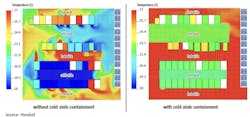We launched a special report series on the new cloud and data center balance. This week we’ll discuss how efficiency, reliability, and the future of digital infrastructure will be impacting your market strategies, and how computational fluid dynamic (CFD) analysis helps you predict what you will need in the near future as well as catch inefficiencies today.
Get the full report
It’s an exciting time to be in the data center space. We continue to see growth around digital solutions as organizations work hard to modernize their business and technology solutions. Working with a good partner can make or break a transformation effort. For cloud providers, ensuring that you have a decentralized and diversified approach to a distributed market is critical.
So, when balancing cloud, data center, and even edge operations, here are some essential services and partner-specific capabilities to look for:
Here’s another important consideration:
Computational Fluid Dynamic (CFD) Analysis. In the past, you could do a CFD once in a while to make sure everything is working correctly. Today, CFD takes data and analytics to a new level. Working with digital clones, data-driven solutions, and even AI, CFD helps you predict what you will need in the near future as well as catch inefficiencies today. Working with CFD is a crucial part of designing a next-generation data center and cloud ecosystem.
CFD is a technique that produces quantitative predictions of fluid flow within a defined system based on the conservation laws governing fluid motion (conservation of mass, momentum, and energy). These predictions are made for a system where physical geometry, physical properties of a fluid, and the boundary and initial conditions of a flow field are well defined. The prediction focuses on a set of fluid variables, such as temperature, pressure, and velocity, describing the fluid flow and heat transfer within the system. CFD complements experimental and theoretical fluid dynamics and is an effective research and design tool.
Some of the advantages of CFD include:
- Generates air temperatures, pressures, and velocities for any location in the system
- Useful in design optimization as modifications and variations can be easily modeled and tested
- Features in the model can be easily switched on and off to allow for faster solution time
- Inexpensive and quick when compared to building and testing design mockups
In the case of CFD, where do partners fit in? The Panduit Professional Services team relies heavily on CFD modeling to assess IT facilities and validate proposed designs. Panduit has found that using CFD to predict the future state of the IT space before deploying proposed designs helps establish a level of trust with customers. It allows various options to be evaluated and the best configuration to be selected with confidence before incurring the cost of deployment. When it is impossible to test or collect data physically, CFD analysis can be used to:
- Determine the optimal configuration of cooling equipment and layout of an IT space
- Identify areas of inefficiency, such as airflow leakage and obstructions
- Identify airflow issues that cannot be seen, such as vortices in the distribution plenum and recirculation of hot air in and around cabinets
- Analyze what-if scenarios, such as an increase in the heat load with the deployment of additional IT equipment, the deployment of additional cabinets, the rearrangement of existing cabinets, or cooling unit failure
- Test the effectiveness of proposed thermal management solutions, such as aisle containment or Vertical Exhaust Systems (VESs)
- Demonstrate to customers the savings associated with different options and predict the Return on Investment (ROI)
Download the full report, “Performance, Efficiency, and Sustainability: The New Cloud and Data Center Balance” courtesy of Panduit for an exclusive case study that looks at how these components and recommendations play out in the real world.
About the Author



